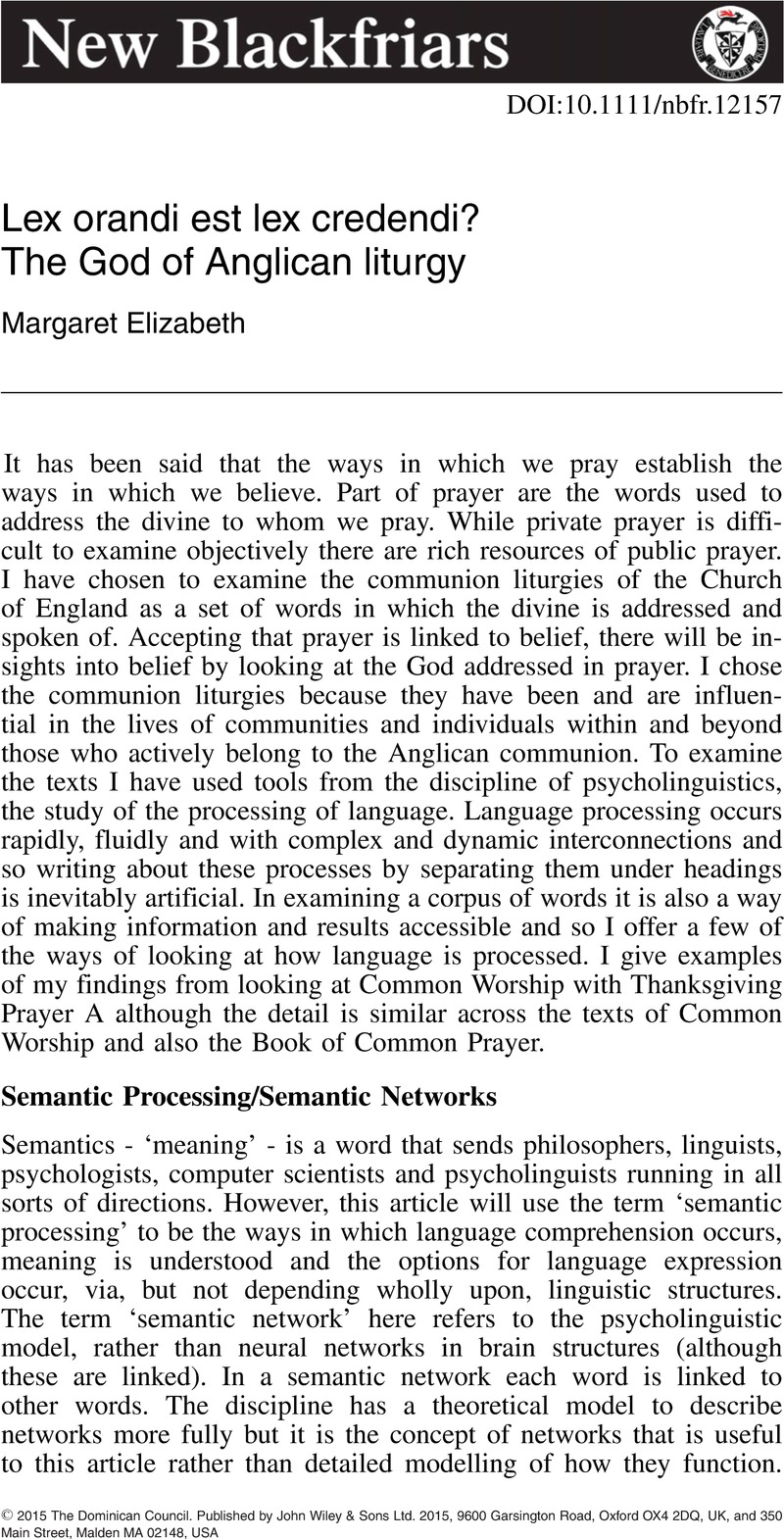Article contents
Lex orandi est lex credendi? The God of Anglican liturgy
Published online by Cambridge University Press: 01 January 2024
Abstract

- Type
- Original Article
- Information
- Copyright
- Copyright © 2016 The Dominican Council. Published by John Wiley & Sons Ltd
References
1 Janssen, N and Barber, H ‘Phrase Frequency Effects in Language Production’ PLoS ONE 7: 3 (2012) e33404 pp1-11CrossRefGoogle ScholarPubMed.
2 Collins, Allan & Loftus, Elizabeth ‘A Spreading-Activation Theory of Semantic Processing’ Psychological Review 82: 6 (1975) pp407-428CrossRefGoogle Scholar.
3 Griffiths, T, Steyvers, M, Tenenbaum, J ‘Topics in semantic representation’ Psychological Review 114: 2 (2007) pp211-244CrossRefGoogle ScholarPubMed.
4 Silkes, J and Rogers, M ‘Masked Priming Effects in Aphasia: Evidence of Altered Automatic Spreading Activation’Journal of Speech, Language and Hearing Research 55 (2012) pp1613-1625 p1613CrossRefGoogle ScholarPubMed.
5 Knobel, M, Finkbeiner, M, Caramazza, A ‘The many places of frequency: evidence for a novel locus of the lexical frequency effect in word production’ Cognitive Neuropsychology 25: 2 (2008) pp 256-286 p256-CrossRefGoogle ScholarPubMed7.
6 Diana, R and Reder, L ‘The low-frequency encoding disadvantage: Word frequency affects processing demands’Journal of Experimental Psychology: Learning, Memory and Cognition 32: 4 (2006) pp 805-815Google ScholarPubMed.
7 Heredia, R and Blumentritt, T ‘On-line Processing of Social Stereotypes During Spoken Language Comprehension’ Experimental Psychology 49: 3 (2002) pp208-221Google ScholarPubMed.
8 Nelson, D, McEvoy, C, Pointer, L ‘Spreading activation or spooky action at a distance?’ Journal of Experimental Psychology: Learning, Memory, and Cognition 29: 1 (2003) pp42-52Google ScholarPubMed.
9 Griffiths et al 2007.
10 Rahman, R and Melinger, A ‘Semantic context effects in language production: A swinging lexical network proposal and a review’ Language and Cognitive Processes 24: 5 (2009) pp713-734CrossRefGoogle Scholar.
11 ie giver of life and life-giving; everlasting and ever living; body and flesh; die, died and death; save and saviour; Jesus Christ, Jesus and Christ; Holy Spirit and Spirit.
12 Dennis, R, Dennis, C, Jobe, L ‘The Meaning of Frequency Words in Different Contexts’ Language and Speech 19: 4 (1976) pp 343-349 p348CrossRefGoogle ScholarPubMed.
13 Wittgenstein, Ludwig Philosophical Investigations (Oxford: Blackwell Publishing Ltd 2009 4th Edition)Google Scholar.
14 Coulson, S ‘Constructing Meaning’ Metaphor and Symbol 21: 4 (2006) pp 245-266CrossRefGoogle Scholar.
15 Wurm, L, Vakoch, D, Seaman, S ‘Recognition of Spoken Words: Semantic Effects in Lexical Access’ Language and Speech 47: 2 (2004) pp175-204 p177CrossRefGoogle ScholarPubMed.
16 Stenberg, G, Lindgren, M, Johansson, M, Olssen, A, Rosén, I, ‘Semantic processing without conscious identification: Evidence from event-related potentials’ Journal of Experimental Psychology: Learning, Memory, and Cognition 26: 4 (2000) pp973-1004Google ScholarPubMed.
17 Scarborough, D, Cortese, C, Scarborough, H ‘Frequency and Repetition Effects in Lexical Memory’ Journal of Experimental Psychology: Human Perception and Performance 3: 1 (1977) pp 1-17Google Scholar.
18 A Groot, de ‘Representational Aspects of Word Imageability and Word Frequency as Assessed Through Word Association’ Journal of Experimental Psychology: Learning, Memory and Cognition 15: 5 (1989) pp824-845Google Scholar.
19 Logan, G ‘On the Ability to Inhibit Complex Movements: A Stop-Signal Study of Typewriting’ Journal of Experimental Psychology: Human Perception and Performance 8: 6 (1982) pp 778-792Google Scholar.
20 Heredia and Blumentritt 2002.
21 Soskice, Janet Martin Metaphor and Religious Language (Oxford: Clarendon Press 1985)Google Scholar.
22 Giora, R ‘Is metaphor special?’ Brain and Language 100: 2 (2007) pp111-114CrossRefGoogle ScholarPubMed.
23 Bowdle, B and Gentner, D ‘The career of metaphor’ Psychological Review 112: 1 (2005) pp193-216 p193CrossRefGoogle ScholarPubMed.
24 Ottati, V, Rhoads, S, Garesser, A ‘The Effect of Metaphor on Processing Style in a Persuasion Task: A Motivational Resonance Model’ Journal of Personality and Social Psychology 77: 4 (1999) pp688-697 p688CrossRefGoogle Scholar.
25 Lakoff, George and Johnson, Mark The Metaphors We Live By (Chicago: The University of Chicago Press 2003 First pub 1980)CrossRefGoogle Scholar.
26 Prat, C, R R, Mason, Just, M M ‘An fMRI investigation of analogical mapping in metaphor comprehension: the influence of context and individual cognitive capacities on processing demands’ Journal of Experimental Psychology: Learning, Memory and Cognition 38: 2 (2012) pp282-294Google ScholarPubMed.
27 Bowdle and Gentner 2005 p211.
28 Glucksberg, S ‘The psycholinguistics of metaphor’ Trends in Cognitive Sciences 7: 2 (2002) pp92-96CrossRefGoogle Scholar.
29 Giora 2007 p112.
30 Bowdle and Gentner 2005.
31 Prat et al 2012.
32 Bowdle and Gentner 2005 p209.
33 Glucksberg 2002 p96.
34 Ibid.
35 Bowdle and Gentner 2005.
36 James, Ross ‘Religious language’ in Davies, Brian OP (Ed) Philosophy: A Guide to the subject of Religion (London: Cassell 1998) pp106-135Google Scholar.
37 Here I am inclined to agree with the eminent linguist David Crystal: “people should be better informed about the language(s) they use;”‘Language and Religion’ In: Sheppard, Lancelot (Ed.): Twentieth century Catholicism (New York: Hawthorn Books 1966) pp 11-28 p 14Google Scholar.
38 The term ‘Holy Spirit’ is not taken from another context and applied to God - God is not said to be Holy Spirit in the way that God is said to be Father or Lord and so the term metaphor is not applicable.
39 Kitayama, S ‘Interaction Between Affect and Cognition in Word Perception’ Journal of Personality and Social Psychology 58: 2 (1990) pp 209-217 p210CrossRefGoogle ScholarPubMed.
40 Kloumann, I, Danforth, C, Harris, K, Bliss, C, Dodds, P ‘Positivity of the English Language’ Open Access Article PLos ONE 7: 1 (2012) pp1 - 7Google ScholarPubMed; Warriner, A, Kuperman, V, Brysbaert, M ‘Norms of valence, arousal and dominance for 13,915 English lemmas’Behaviour Research Methods 45: 4 (2013) pp1191-1207CrossRefGoogle ScholarPubMed.
41 I Kloumann et al 2012 p5.
42 Son, J-S, Do, V, Kim, K-O, Suwonsichon, T, Valentin, D ‘Understanding the effect of culture on food representations using word associations: The case of “rice” and “good rice”’Food Quality and Preference 31 (2014) pp38-48CrossRefGoogle Scholar.
43 Kuperman, V, Estes, Z, Brysbaert, M, Warriner, A ‘Emotion and Language: Valence and Arousal Affect Word Recognition’ Journal of Experimental Psychology: General Advance online publication (2014) pp1-17Google Scholar.
44 Pope Pius XII Mediator Dei http://w2.vatican.va/content/piusxii/en/encyclicals/documents/hf_pxii_enc_20111947_mediator-dei.html Accessed 23.4.15.
- 3
- Cited by




